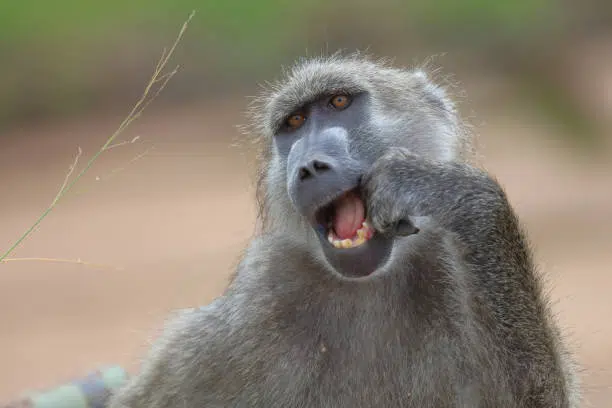Table of Contents
Scientific Classification
| Kingdom | Animalia |
| Phylum | Chordata |
| Class | Mammalia |
| Order | Primates |
| Family | Cercopithecidae |
| Genus | Papio |
| Species | P. ursinus |
| Scientific Name | Papio ursinus |
Description
The Chacma baboon (Papio ursinus) holds the title of the largest baboon species. You can easily spot these fascinating creatures roaming the savannas and mountains of Africa. They have a robust, dog-like build, with males typically reaching lengths of over 115 cm (45 inches). Their long tails, which can curve down and add another 70 cm (27 inches), give them a distinctive look. Adult males can weigh as much as 40 kg (88 lbs), making them quite impressive in size, and they exhibit intricate social behaviors.
Their shaggy fur is coarse and can range from dark brown to grey, depending on their habitat and climate. The face is bare yet expressive, featuring a long, dog-like snout and sharp, intelligent eyes. Males are larger and sport sharp canine teeth, which they display during threat gestures and dominance displays.
What truly sets the Chacma baboon apart is its rich social life. Observing a troop is like peering into a miniature society—it’s organized, strategic, and surprisingly relatable.

Distribution
Chacma baboons are found all over southern Africa.
Habitat
The Chacma baboon is a true survivor, thriving in a wide variety of habitats. You can find these clever primates in savannas, woodlands, deserts, and even mountains. They really know how to make the most of their surroundings, always on the lookout for food, water, and safe places to rest.
In the stunning Drakensberg Mountains, these troops navigate cliffs and rocky terrain with ease, using the elevation to escape from predators. Down along South Africa’s coast, they sometimes venture into towns, rummaging through garbage bins and even homes. While this behavior can stir up some controversy, it’s a testament to their intelligence and adaptability.
Finding safe sleeping spots is crucial for the troop’s safety. Baboons often huddle together near cliff faces, under large trees, or in caves. This not only keeps them warm but also helps shield them from any nighttime dangers.
Diet
Chacma baboons are fascinating omnivores, showcasing an impressive ability to adapt their diet. They primarily munch on a variety of plants, including grasses, roots, tubers, seeds, and fruits. However, they don’t shy away from animal protein when it’s on the menu.
These clever creatures will also snack on insects, small reptiles, birds, eggs, and even tiny mammals. In certain areas, they’ve been known to team up to hunt vervet monkeys and antelope fawns, demonstrating their remarkable group hunting skills—something we don’t often see in non-human primates.
Unfortunately, their eating habits can lead to conflicts with humans, particularly in agricultural regions. They often raid crops like corn, sweet potatoes, and citrus fruits, causing quite a stir among farmers.
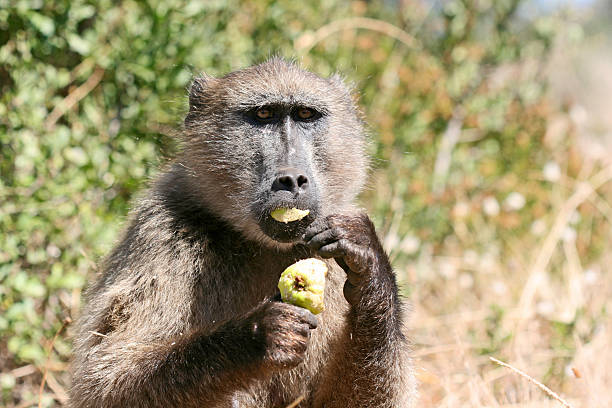
Behavior
Chacma baboons are incredibly social creatures, living in troops that can range from 20 to over 100 members. Within these groups, there’s a clear hierarchy, with each baboon holding a specific rank that influences their access to food, mates, and grooming partners.
As they mature, males typically leave their birth group in search of a new troop where they can establish dominance. On the other hand, females tend to remain with their original group, forming strong matrilineal bonds that last a lifetime.
Grooming plays a vital role in their social interactions. Not only does it help keep parasites at bay, but it also reinforces social connections. You’ll often see lower-ranking baboons grooming those higher up in the hierarchy, which helps everyone understand their place within the group.
Baboons are diurnal, meaning they’re active during the day and rest at night. Their daily activities include foraging for food, playing, socializing, and keeping a watchful eye out for predators. They have a rich communication style that includes vocalizations, gestures, facial expressions, and even body language.
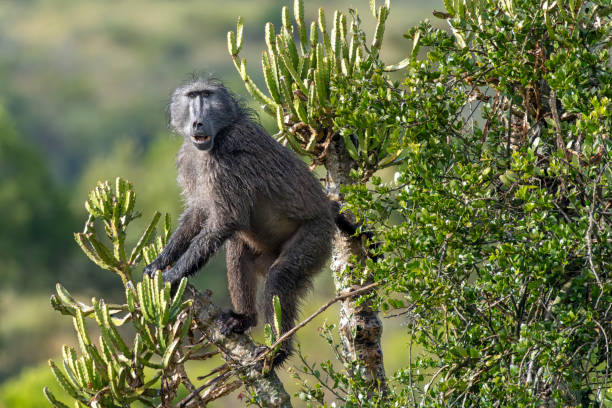
Lifespan
In the wild, Chacma baboons can live up to 30 years, but most typically only make it to around 20 to 25 years. This shorter lifespan is often due to dangers like predators, diseases, or injuries. However, in captivity, where they receive proper nutrition and medical care, they can live much longer, sometimes even surpassing 35 years.
Interestingly, female baboons tend to outlive their male counterparts. Males often deal with more stress from dominance struggles and the challenges of moving with their troop.
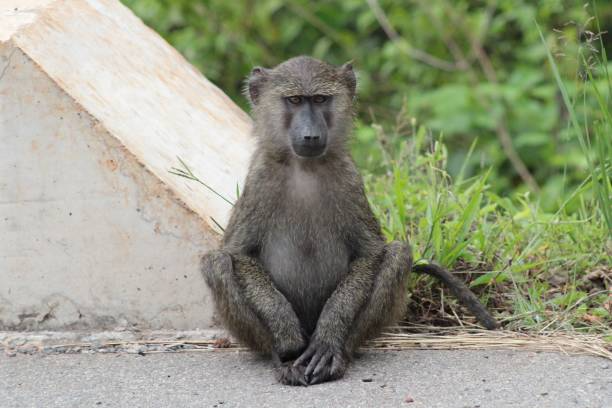
Reproduction and Lifecycle
Chacma baboons don’t stick to a specific breeding season, but you’ll notice more births when food is abundant. When a female baboon swells up, it’s a clear sign she’s ready to mate, which leads to some fierce competition among the dominant males.
Once mating is successful, the gestation period lasts about six months. Typically, a female will give birth to one baby. The little one arrives with black fur and a pink face, looking quite different from the adults. The mother is incredibly attentive, carrying her infant in front of her for the first few weeks, and then the baby hops on her back for rides.
Infants usually wean off breast milk between six to twelve months and stick close to their mothers until they can stand on their own, which generally happens around the age of two.

Predators
Despite their size and group living, Chacma baboons face several natural predators. These include:
- Lions
- Leopards
- Hyenas
- African wild dogs
- Crocodiles (when near water sources)
- Large birds of prey (which can snatch juveniles)
Their best defense is unity—troops will mob a predator by barking, lunging, or even attacking en masse. Males in particular may risk injury or death to protect the group, especially infants.
Adaptations
The Chacma baboon survives thanks to many physical and behavioral adaptations:
- Opposable thumbs and dexterous fingers enable them to manipulate tools and food.
- Powerful limbs and agile movements help them climb trees or cliff faces to escape danger.
- Acute vision and vocal alarms serve as early-warning systems for predators.
- Social intelligence allows complex troop interactions and strategic alliances.
- Memory and problem-solving skills facilitate navigation, food acquisition, and even deceit.
In cities or nearby areas, they show great creativity. They can open car doors and navigate trash bins with surprising skill.
Mating Season
Chacma baboons can mate all year, but they often have a peak during the wet season. This is when food is plentiful. This increase in resources supports the nutritional demands of pregnancy and lactation.
During these times, competition among males intensifies. High-ranking males may guard females during estrus. This behavior, called mate guarding, limits rivals’ access. Sometimes, females mate with lower-ranking males. They might do this to confuse paternity and reduce the risk of infanticide.

Breeding
Females give birth about every two years. This depends on how stable the environment is and how much food is available. During periods of drought or food scarcity, reproductive rates drop significantly.
Female reproductive success is strongly influenced by social rank. Top females receive more grooming, find better foraging spots, and raise healthier young.
Once born, infants become the focus of attention within the troop. Juveniles play in ways that mimic adult behavior. They fight, chase, and even mock mate. This playful behavior helps them get ready for their future social roles.
Interesting Facts
- Did you know that baboons have an impressive repertoire of over 30 different vocal sounds? They can bark, scream, grunt, and even let out a “wahoo!”
- Chacma baboons are known to grieve for their lost ones, with mothers often carrying their deceased infants for days on end.
- These fascinating creatures also exhibit cultural behaviors, such as grooming rituals and unique food-gathering techniques that are passed down through generations.
- Baboons are quite resourceful, using tools like sticks to help them forage and rocks to crack open their food.
- Interestingly, some baboon troops have been known to raid human settlements, almost like they’re planning a heist, complete with lookouts and coordinated retreats.
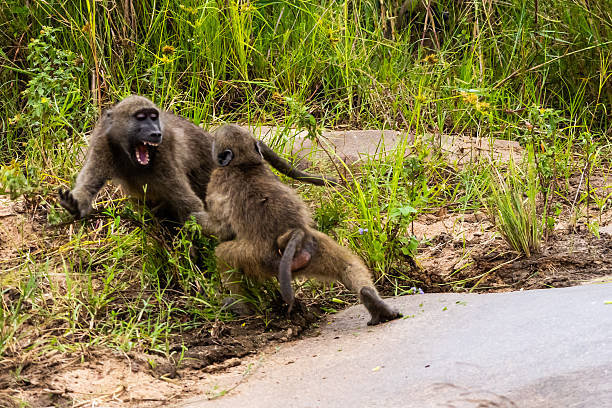
Conservation Status
When it comes to conservation status, the Chacma baboon is currently classified as Least Concern by the IUCN Red List. This status highlights their widespread presence and adaptability. However, local populations are increasingly threatened by habitat loss, hunting, and conflicts with humans.
In agricultural regions, they’re often seen as pests, which can lead to culling or poisoning. The expansion of urban areas also results in road accidents and fragmented habitats, both of which negatively impact troop cohesion and their chances of survival.
Conservationists emphasize the importance of strategies that promote coexistence. These strategies include implementing “baboon-proof” waste disposal systems, launching public education campaigns, and creating protected ecological corridors. By taking these steps, we can help minimize conflicts and support the natural behaviors of these remarkable animals.
Conclusion
The Chacma baboon is more than just another primate from Africa. It’s incredibly intelligent, adaptable, and has a rich emotional life. Its ability to thrive in various environments is a testament to its flexible evolution. Plus, the way it forms social bonds has some striking similarities to human relationships.
As humans encroach on their natural habitats, the future of the Chacma baboon hinges on its ability to adapt. This survival depends on our willingness to respect, understand, and find ways to coexist with this remarkable species.


